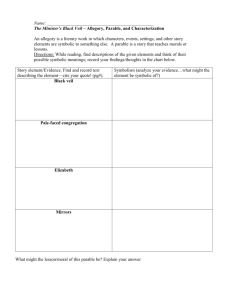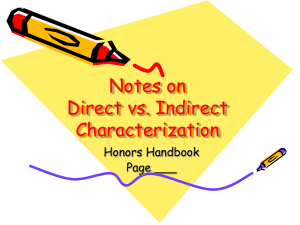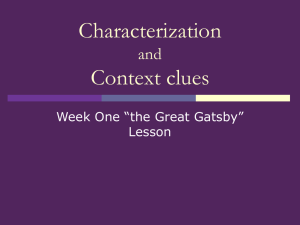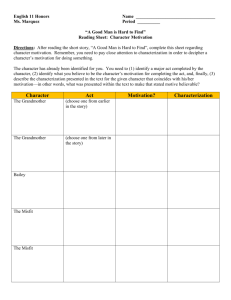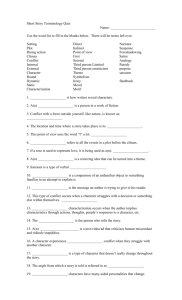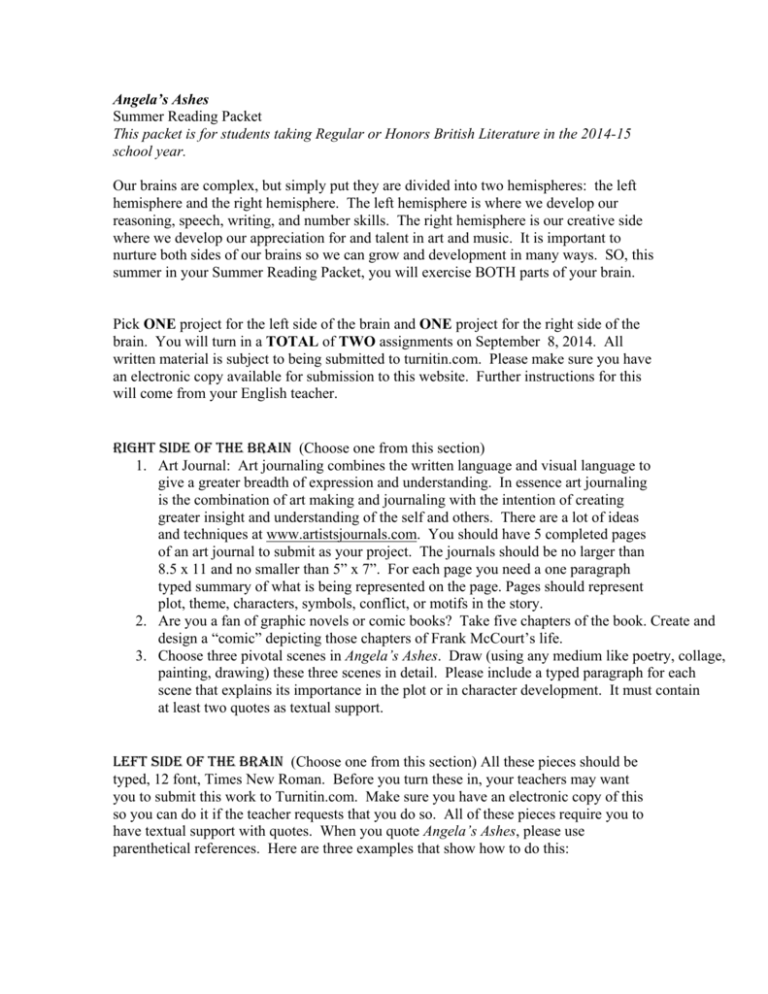
Angela’s Ashes
Summer Reading Packet
This packet is for students taking Regular or Honors British Literature in the 2014-15
school year.
Our brains are complex, but simply put they are divided into two hemispheres: the left
hemisphere and the right hemisphere. The left hemisphere is where we develop our
reasoning, speech, writing, and number skills. The right hemisphere is our creative side
where we develop our appreciation for and talent in art and music. It is important to
nurture both sides of our brains so we can grow and development in many ways. SO, this
summer in your Summer Reading Packet, you will exercise BOTH parts of your brain.
Pick ONE project for the left side of the brain and ONE project for the right side of the
brain. You will turn in a TOTAL of TWO assignments on September 8, 2014. All
written material is subject to being submitted to turnitin.com. Please make sure you have
an electronic copy available for submission to this website. Further instructions for this
will come from your English teacher.
Right side of the brain (Choose one from this section)
1. Art Journal: Art journaling combines the written language and visual language to
give a greater breadth of expression and understanding. In essence art journaling
is the combination of art making and journaling with the intention of creating
greater insight and understanding of the self and others. There are a lot of ideas
and techniques at www.artistsjournals.com. You should have 5 completed pages
of an art journal to submit as your project. The journals should be no larger than
8.5 x 11 and no smaller than 5” x 7”. For each page you need a one paragraph
typed summary of what is being represented on the page. Pages should represent
plot, theme, characters, symbols, conflict, or motifs in the story.
2. Are you a fan of graphic novels or comic books? Take five chapters of the book. Create and
design a “comic” depicting those chapters of Frank McCourt’s life.
3. Choose three pivotal scenes in Angela’s Ashes. Draw (using any medium like poetry, collage,
painting, drawing) these three scenes in detail. Please include a typed paragraph for each
scene that explains its importance in the plot or in character development. It must contain
at least two quotes as textual support.
Left side of the brain (Choose one from this section) All these pieces should be
typed, 12 font, Times New Roman. Before you turn these in, your teachers may want
you to submit this work to Turnitin.com. Make sure you have an electronic copy of this
so you can do it if the teacher requests that you do so. All of these pieces require you to
have textual support with quotes. When you quote Angela’s Ashes, please use
parenthetical references. Here are three examples that show how to do this:
“Dad nods and puts his hand in mine again. He looks at me, steps away, stops, comes
back, kisses me on the forehead for the first time in my life and I’m so happy I feel like
floating out of the bed” (193). Page number is in parenthesis and punctuation is after
that.
Frank describes his adolescence as “the ordinary miserable childhood is the miserable
Irish childhood, and worse yet is the miserable Irish Catholic childhood” (11). Page
number is in parenthesis and punctuation is after that.
The “River Shannon” is a nickname for the flooding that occurs in their living room.
This would NOT be considered a quote, but definitely needs to be in quotes because it is
special reference made in the McCourt household. Also notice no page number is used,
because it is used repeatedly through out and is only two words.
To embed a quote means to use it in the paragraph in such a way that it doesn’t interrupt
the fluidity of the discussion. Quotes should be used to illustrate or punctuate a point you
are making.
1. Read Time Magazine’s obituary of Frank McCourt, author of Angela’s Ashes. In the obituary,
Grossman comments on McCourt’s first exposure to Shakespeare and his love for reading that
insued. Compare and contrast McCourt’s love of and need for reading to today’s American
teenager’s boredom of and indifference to reading. You must have at least 4 quotes embedded in
the text of the paper using specific details from the text to support your claims about McCourt.
(1200 word maximum)
2.
Please read the article on Direct vs. Indirect Characterization by Terry Ervin. As you read, the
article, think of Angela’s Ashes and Frank McCourt’s character. Your teacher says to you in
class: “Tell me all about Frank McCourt as a boy in New York and Limerick.” Write the
character analysis including both direct and indirect character traits about Frank McCourt. Be sure
to include the things you think are his bad points as well as his good points, based on how he
describes his actions and feelings in the book. You must include a minimum of 5 quotes from text
that support your character analysis. (1200 words maximum)
Direct vs. Indirect Characterization
by Terry W. Ervin II
Characterization is an important element in almost every work of fiction, whether it is a short
story, a novel, or anywhere in between. When it comes to characterization, a writer has two
options:
1. DIRECT CHARACTERIZATION - the writer makes direct statements about a character's
personality and tells what the character is like.
2. INDIRECT CHARACTERIZATION - the writer reveals information about a character and his
personality through that character's thoughts, words, and actions, along with how other
characters respond to that character, including what they think and say about him.
An alert writer might recognize that the two methods of characterization fall under the decision to
“show” or to “tell”. Indirect characterization “shows” the reader. Direct characterization “tells” the
reader.
As with most “show” versus “tell” decisions, “showing” is more interesting and engaging to the
reader, and should be used in preference to “telling”. Does that relegate direct characterization to
the prose trash heap? No. There are times when direct characterization is useful. Whereas
indirect characterization is more likely to engage a reader’s imagination and paint more vivid
images, direct characterization excels in brevity, lower word count, and moving the story forward.
For example, a writer may want to reveal a minor facet of a character’s personality without
distracting from the action in a scene. It is up to the writer to decide when each characterization
method is appropriate.
To observe the difference between direct and indirect characterization, read the paired
paragraphs below. Each is written to convey the same basic information. One of each pair
demonstrates direct characterization while the other demonstrates indirect characterization. See if
you can identify which method is being used.
Paragraph Pair 1:
A. Ed Johnson scratched his head in confusion as the sales rep explained Dralco’s newest
engine performance diagnostic computer. The old mechanic hated modern electronics, preferring
the old days when all he needed was a stack of manuals and a good set of tools.
B. “That Ed Johnson,” said Anderson, watching the old mechanic scratch his head in confusion
as the sales rep explained Dralco’s newest engine performance diagnostic computer. “He hasn’t
got a clue about modern electronics. Give him a good set of tools and a stack of yellowing
manuals with a carburetor needing repair, and he’d be happy as a hungry frog in a fly-field.”
Paragraph Pair 2:
A. Julie owned a multitude of outfits and accessories, and it always took her forever to decide
which combination might impress Trent. As usual, she called her sister several times for advice.
After doing so, Julie decided to give the navy blue skirt with the white sweater a try.
B. Julie held up six different outfits in front of the mirror and pondered which would go best with
her navy blue shoes, pastel eye shadow and the diamond earrings she’d already procured from
her overflowing vanity. After ninety minutes of mixing and matching, and cell-phoning her sister
three times for advice, Julie finally made up her mind. She’d give the navy blue skirt and white
sweater a try, hoping Trent would love it.
In both instances, Paragraph A illustrates an example of direct characterization (telling) while
Paragraph B provides an example of indirect characterization (showing). While one might quibble
with the quality of each paragraph (or Julie’s fashion sense), the direct characterization examples
are shorter, leaving less imagination to the reader, while still getting the same basic information
across. Which is most appropriate depends on the needs and concerns of the writer.
© Copyright Terry W. Ervin II. All rights reserved.
3. The death of one of Frank’s twin brothers adds to the misery of the McCourt’s povertystricken life. The family has no money to pay for the undertaker to bury Oliver or to buy food
and other necessities. The family is reduced to begging in the streets and shops until Malachy
is eligible to receive welfare money from the government (called the “dole”). When he finally
is eligible, he collects the money, but instead of bringing it home to Angela, he goes to the pub
and drinks it all away. Imagine you are a social worker who finds out that the McCourt
children are going hungry. Write a report for your supervisor, describing the family’s situation
and what you think should be done about it. A minimum of 5 quotes should be used here as
textual evidence for the abuse and horrible conditions under which Frank and his family live.
(1200 word maximum) Begin your report:
Case of the Family of Malachy and Angela McCourt:
Upon my first visit to the family home on Hartstronge Street, I found….
4. There are many scenes in this book that are very dramatic and powerful. Choose the three
scenes that you feel are the most powerful; construct a five paragraph essay discussing the
scenes, their importance to the story, and the impact of them on Frankie’s life. You should
have a minimum of 4 quotes embedded in your essay. (1200 word maximum)
Common Core Standards: Reading for Literature: 1,2,3,7; Writing: 1,2,4,6,7,8;
Language Standards: 1,2,3,4,5

